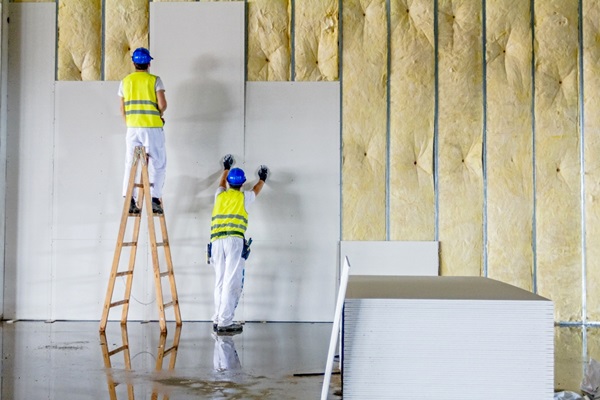Comprehensive Drywall Contractor Support for New Builds
Comprehensive Drywall Contractor Support for New Builds
Blog Article
Drywall Setup Made Easy: Tips for Perfect Results
Drywall installment is typically perceived as an overwhelming task, yet with the appropriate method and expertise, it can become a convenient endeavor. Understanding techniques for reducing, hanging, and ending up drywall can considerably influence the outcome.
Selecting the Right Products
Selecting the proper materials for drywall installation is vital to achieving a resilient and cosmetically pleasing finish. drywall contractor. The main element, drywall sheets, typically been available in different densities, with 1/2-inch sheets being standard for interior walls. For locations calling for added moisture resistance, such as restrooms or kitchen areas, consider using eco-friendly board or cement board, which are specifically made to hold up against humidity

In addition, picking the ideal bolts-- either screws or nails-- is vital for securing the drywall to the framing. Drywall screws are typically favored for their holding power and lowered danger of popping. Take into consideration the finishing touches such as guide and paint, which not only enhance the look however also protect the drywall from dampness and wear.
Preparing the Setup Area
Before starting the drywall installation process, it is important to prepare the installment area completely. A tidy work area decreases the risk of damages to existing things and enables for reliable movement during installment.
Next, examine the wall surfaces and ceiling for any flaws, such as splits, openings, or mold. Address these problems ahead of time; patch any problems and permit sufficient time for repair services to completely dry. Additionally, guarantee that electric outlets, buttons, and plumbing are correctly positioned and made up, as this will certainly impact drywall placement.
Think about the environmental conditions. A steady temperature and humidity level are vital for optimal adhesion and performance of the drywall products. If essential, make use of a dehumidifier or heating system to produce ideal problems.
Trimming and Hanging Drywall
The key to reliable drywall setup lies in the precise cutting and dangling of the panels. Use a straight side and an energy knife to rack up the drywall along your measurements, then break it along the scored line for a clean break.

Constantly work from the top down and entrusted to right, ensuring that you preserve a staggered pattern to boost stability. Effectively hanging the drywall sets the foundation for a smooth coating, ultimately causing superior cause your drywall job.
Insulation and Mudding Techniques
While appropriate cutting and dangling of drywall sets the stage, the next critical step includes grasping read this taping and mudding strategies to ensure a seamless surface. Insulation is essential for strengthening joints and protecting against cracks; it involves embedding tape into the used joint substance (mud) Beginning with a quality fiberglass or paper tape, applying the tape over the joint and pressing it into the wet mud utilizing a taping blade, making certain no air bubbles continue to be.
Once the tape is in area, use a thin layer of joint substance over the tape, feathering the edges to produce a smooth transition to the drywall surface. Enable this layer to dry entirely prior to sanding it lightly to eliminate imperfections. Repeat this procedure, using additional coats of mud as essential-- normally two to 3 coats-- while slowly broadening the application area with each layer to accomplish a seamless look.
After the final coat dries out, sand the surface area with a fine-grit sandpaper till smooth. drywall installation. Keep in mind to wear a mask during sanding to stay clear of breathing in dirt bits. Grasping these taping and mudding techniques is crucial for achieving a drywall repair professional-quality finish in your drywall installation
Ending Up Touches for Excellence
Accomplishing a perfect drywall installation goes beyond mudding and taping; it finishes in the completing touches that elevate the total look. These final steps are critical in making certain a professional-grade surface that improves the visual appeals of your space.
Begin by sanding the dried out joint compound to develop a smooth surface. drywall installation. After fining sand, wipe down the wall surfaces with a damp fabric to remove any type of dirt bits, making certain a clean surface area for painting.
Next, use a primer particularly designed for drywall. This step is crucial, as it assists secure the joint compound and offers a consistent base for the topcoat. When the guide dries out, examine for any kind of imperfections, and retouch as required.
Conclusion
In final thought, effective drywall installation rests on the cautious option of materials, extensive prep work of the installation area, and exact implementation of reducing and hanging methods. Mastery of taping and mudding processes is essential for achieving a smooth finish. In addition, attention to ending up touches, consisting of priming and touch-ups, ensures a professional-grade result. By adhering to these guidelines, the quality of handiwork can be dramatically improved, contributing to the general aesthetic and performance of the area.
Drywall installation is usually regarded as a difficult task, yet with the best method and understanding, it can come to be a workable endeavor.Selecting the ideal materials for drywall installment is vital to accomplishing a long lasting and cosmetically pleasing coating.Before starting the drywall installation procedure, it is important to prepare the setup area thoroughly. Mastering these taping and mudding methods is address important for attaining a professional-quality finish in your drywall setup.
In verdict, successful drywall installment hinges on the cautious selection of materials, thorough preparation of the setup location, and accurate implementation of cutting and hanging methods.
Report this page